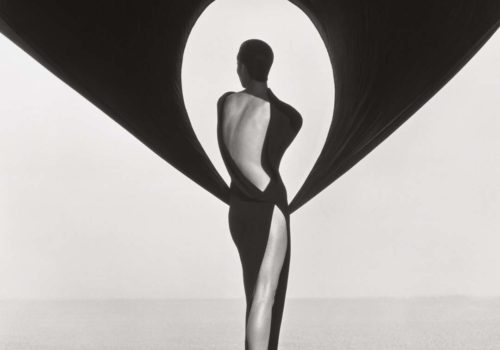The glamour and beauty of the human body will be on display in an exhibit straight from breaking attendance numbers at the Getty Museum in Los Angeles California. Herb Ritts: L.A. Style, on view at the Cincinnati Art Museum October 6th through December 30, 2012, explores the photographer’s career portraying figures from Richard Gere and Madonna to other notables, as well as Ritts’ innovative nudes and fashion images. L.A. Style includes a selection of renowned and previously unpublished photographs, as well as Ritts’ projects directing music and fashion videos. A major portion of the works in the exhibition was recently acquired by the Getty Museum through purchase and in the form of a generous gift from the Herb Ritts Foundation. L.A. Style is accompanied by a 206-page book that, in addition to reproductions of the works in the exhibition, contains incisive essays by Paul Martineau and James Crump.
Herb Ritts (1952–2002) was a Los-Angeles based photographer who revolutionized fashion photography, modernized the nude, and transformed celebrities into icons. L.A. Style presents Ritts’ intimate portraiture, his modern yet classical treatment of the nude, and his innovative approach to fashion which brought him international acclaim and placed him securely within an American tradition of portrait and magazine photography that includes Richard Avedon, Robert Mapplethorpe, and Irving Penn.
Ritts’ portraits of celebrities such as Richard Gere, Britney Spears, Mel Gibson, and Madonna introduce the exhibition. His anti-glamour style of portraiture made celebrities look more natural and allowed them to reveal inner qualities, making them more accessible to fans. By the late 1980s, Ritts’ reputation as a shaper of fame made him a celebrity in his own right, and the iconic status of such photographs as Richard Gere, San Bernardino (1977) and Madonna, Hollywood (1986) made a photograph by Ritts a rite of passage among Hollywood insiders.
“Ritts’ fondness for the “golden hour,” that brief period of golden California light, and his choice of plein air settings underscore Ritts’ distinct aesthetic vision,” says James Crump, Chief Curator at the Cincinnati Art Museum. “These attributes helped distinguish Ritts from many of his East Coast peers.” The exhibition continues with Ritts’ fashion photographs, many of which drew inspiration from painting, sculpture, film, and the work of such leading fashion and portrait photographers as Richard Avedon, Horst P. Horst, George Hurrell, Irving Penn, and Louise Dahl Wolfe. As hundreds of magazine spreads demonstrate, Ritts kept top fashion editors happy by providing dazzling pictures designed to sell clothes along with others that simply celebrated beauty.
The exhibition then examines how Ritts—along with his contemporaries Robert Mapplethorpe and Bruce Weber—provoked a radical change in how the nude was depicted. His forte was an ability to analyze the body from a variety of angles and create compositions that abstracted it in ways that communicated strength and poise. Ritts’ work also includes portraits of well-known athletes and dancers. In the exhibition are a series of photographs of the critically acclaimed American dancer and choreographer Bill T. Jones. In these photographs, Ritts captured Jones while he danced, framing him against a pure white background and thus making his muscled body look like a piece of sculpture. He also photographed famous athletes including Michael Jordan, Magic Johnson, and Olympic gold-medalist Greg Louganis.
Although Ritts had no prior experience with film, Madonna convinced him to direct his first music video for her song “Cherish” (1989), which is included in the exhibition along with other music videos and commercials. From 1989 until 2002, Ritts directed thirteen music videos and more than fifty commercials. Some of his music industry clients included Michael Jackson, Janet Jackson, Mariah Carey, Britney Spears, and Shakira, while his commercial clients were mainly fashion and cosmetic companies such as Chanel, Lancôme, Estée Lauder, and Calvin Klein. From the late 1970s until his untimely death in 2002, Ritts’ images that bridged the gap between art and commerce are not only a testament to the power of his imagination and technical skill, but also the union between art, popular culture, and commerce that followed in the wake of the Pop Art movement of the 1960s and 1970s.
Herb Ritts: L.A. Style
October 6 – December 30, 2012
Cincinnati Art Museum
953 Eden Park Drive,
Cincinnati, OH 45202
USA
T : (513) 639-2995
Curated by Paul Martineau for the J. Paul Getty Museum, Los Angeles.
Organizing curator, James Crump, Chief Curator
Tuesday through Sunday, 11 a.m. to 5 p.m, closed on Mondays
















